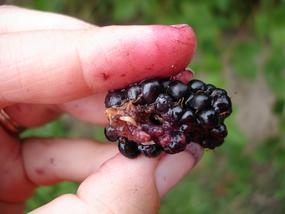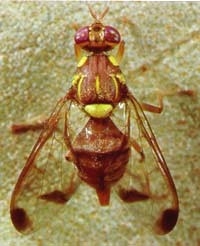Posts Tagged: exotic
Pests present border threat
"Whether they know it or not, every person in the country is affected by this, whether by the quality or cost of their food, the pesticide residue on food or not being able to enjoy the outdoors because beetles are killing off the trees," said Mark Hoddle, an entomologist specializing in invasive species at the University of California, Riverside.
Springs rains blamed for sudden oak death increase
Guy Kovner, The (Santa Rosa) Press Democrat
The level of sudden oak death infection in Sonoma County and other parts of the Bay Area tripled over last year's rate, according to a survey conducted in June in nine counties from Humboldt to Monterey.
“It's a red flag,” said Matteo Garbelotto, head of UC Berkeley's forest pathology laboratory.
What sustainability means in agriculture
Amanda Radke, Tri-State Livestock News
Amada Radke reported on a panel discussion on agricultural sustainability, which took place at UC Davis in September. The panel included farmers, activists and the dean of the UC Davis College of Agriculture and Environmental Sciences Neal Van Alfen.
“There is so much debate and controversy among naturally-raised foods and conventionally-raised foods, and that's too bad, because one isn't always better than the other,” said Van Alfen. “If we don't make our system work, we are all in trouble. We have to figure out how to feed the world sustainably. Research is so important to help farmers reduce input costs and work to make organic foods more sustainable and efficient.”
Invasive melon fly trapped in Fresno County
CDFA officials have trapped a single male melon fly in a Fresno vineyard, sending shivers down the spines of local farmers who produce its target crops, including cucumber, eggplant, squash and tomatoes, according to a report on the CBS Channel 47 news.
The melon fly is native to Asia, but has spread to other parts of the world, including Africa and the Pacific Islands. Melon flies were first found in California in 1956 and have been captured sporadically over the years, but all infestations have been successfully eradicated. Just last year, eight melon flies were found in Kern County. Trapping last month determined that the Kern County population was eradicated, the story said.
Reporter Tony Botti spoke to UC Cooperative Extension farm advisor Richard Molinar about the potential economic damage of a melon fly infestation to small-scale farms. If the pest is found in greater numbers, CDFA will likely impose a quarantine, which stops farmers from moving any of their products out of the area.
"If they are not able to sell, they are going under," Molinar said. "They’ll take a loss this year and many won't be able to survive a loss."
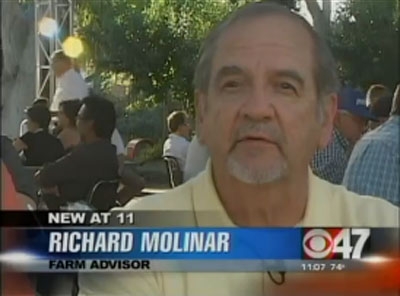
UCCE farm advisor Richard Molinar speaks about melon fly on the CBS Channel 47 news.
Another palm tree infested with red palm weevil
Officials have confirmed that the red palm weevil is not confined to a single palm tree in Laguna Beach, according to a story in the Daily Pilot. Just blocks from the first infested tree, another Canary Islands date palm is being killed by red palm weevil.
UC Riverside Cooperative Extension entomologist Mark Hoddle said the crown of the second infested palm has dropped off, and the top of the trunk is ringed with a 'halo' of palm fronds.
"The trunk of the palm has been heavily damaged internally by feeding red palm weevils. The central portion of the trunk now contains a highly fermented and very wet 'mash' of plant material," the story quoted Hoddle.
The dying tree contained portions of at least nine dead adult weevils, one live adult and seven empty pupal cases.
It is now likely that additional palms in North Laguna are infested with this destructive pest, the story said.
CDFA, the Orange County Ag Commissioner, USDA and UC Cooperative Extension are hosting the first of several informational meetings from 10 a.m. to 12 noon Friday, Nov. 5, in the Laguna Beach City Council Chambers, 505 Forest Ave. At the meeting, experts will inform local government officials, arborists, public works officials, landscapers and pest control advisers about the current red palm weevil situation and how to identify the pest and its feeding damage.
Future meetings will target other industry members and the public.
Details about the meeting and more information are on the UC Riverside Center for Invasive Species Research blog.
Southern California Public Radio's Madeline Brand interviewed Hoddle about red palm weevil for a story broadcast last Friday.
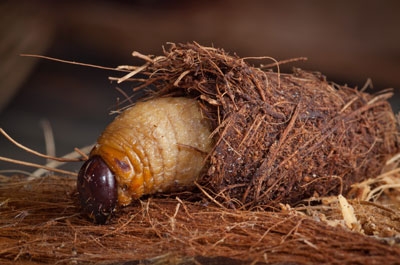
Red palm weevil larva emerges from its cocoon.
Red palm weevil found in Orange County
Palm tree growers, government officials and UC scientists are moving quickly to prevent the spread of red palm weevil, which made its first U.S. appearance a month ago in Laguna Beach, according to an article in the Riverside Press-Enterprise. The pest has caused enormous damage to palm trees in other parts of the world. Its larvae excavate large holes in the trunks of many types of palms - including coconut, date and oil palms, canary, queen and fan palms - killing a mature tree in about a year.
"This is central to our livelihood," the story quoted Albert Keck, chair of the California Date Commission and a third-generation date farmer.
Press-Enterprise reporter Mark Muckenfuss noted in the story that concern about the palm tree pest goes well beyond farmers' pocketbooks. Palm trees add a distinctive character to local landscapes.
"Palms are iconic to California," Keck was quoted.
Originally from Southeast Asia, the red palm weevil has spread to Africa and Europe, reaching the Mediterranean in the 1980s. It was first recorded in Spain in 1994.
UC Riverside entomologist Mark Hoddle said the weevil was probably brought into the United States as eggs, larvae or pupae hidden inside imported palms.
"These can travel great distances because they live with their food supply," Hoddle said.
A UC Riverside news release said scientists, growers and regulators will gather at 2 p.m., Friday, Oct. 29, at UC Riverside to discuss a collaborative effort to manage red palm weevil and a campaign to alert and educate Southern California homeowners about the threat.
Detailed information about red palm weevil is on the UC Center for Invasive Species Research website.

Red palm weevils are quite large and have a slender snout.
USDA provides funds for California specialty crops research
The USDA issued a news release on Friday announcing $55 million in block grants to enhance the competitiveness of specialty crops around the country, with California receiving more than $17 million. Of the 64 California projects, 19 are led by researchers affiliated with UC Agriculture and Natural Resources.
A large share of funding - $1.4 million - goes to nine food-safety projects to be coordinated by UC’s Center for Produce Safety, according to an article in the Fresno Bee.
"Scientists and researchers with the University of California and industry groups are exploring everything from whether frogs and lizards are potential carriers of E.coli to whether dust from a cattle operation can carry E.coli into a vegetable field," wrote Bee reporter Robert Rodriguez.
The executive director of the Center for Produce Safety, Bonnie Fernandez, told Rodriguez the funding comes at a time of heightened awareness of food safety among consumers and farmers.
"There are simply a lot of unanswered gaps of knowledge on these issues," Fernandez was quoted. "We want to know where the pathogens came from, how it attaches to a product and how we can reduce the risk of that happening."
Management of exotic pests is another issue where USDA provided funding for UC research, according to the listing on USDA's website. For example, grants will support efforts to:
- Release and evaluate four exotic olive fruit fly parasitoids in order to improve sustainable table and oil olive management
- Test the area-wide application of mating disruption of vine mealybug in Napa County
- Evaluate the efficacy of organic pesticides for Asian Citrus Psyllid control so science-based control recommendations can be made to organic citrus growers
- Survey resistance ratios in olive fruit fly populations from California regions not sampled in a previous study
Funds were also made available to expand and improve the online specialty crop production information now available on UC's Fruit & Nut Research and Information Center website and call-in center.
In addition, the new funding will allow UC researchers to work with several school districts and their regional partners to expand their procurement of local seasonal fresh produce, enhance their ability to integrate a specialty crop nutritional curriculum by providing outreach and professional development to school personnel, and assess changes in food preferences and dietary behaviors of children in participating school.
Other UC projects receiving the funding will look into onion seed production, strawberries' ability to restore impaired insulin, steam injection for soil disinfestation, and mealy plum aphid and leaf-curl plum aphid control in prunes.
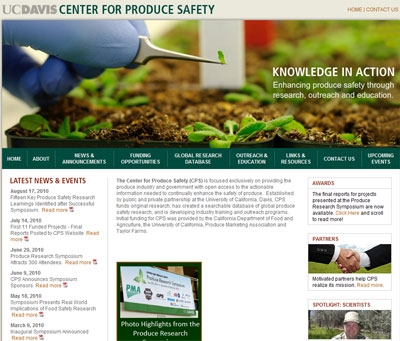
The UC Center for Produce Safety to receive substantial research funds from USDA.

